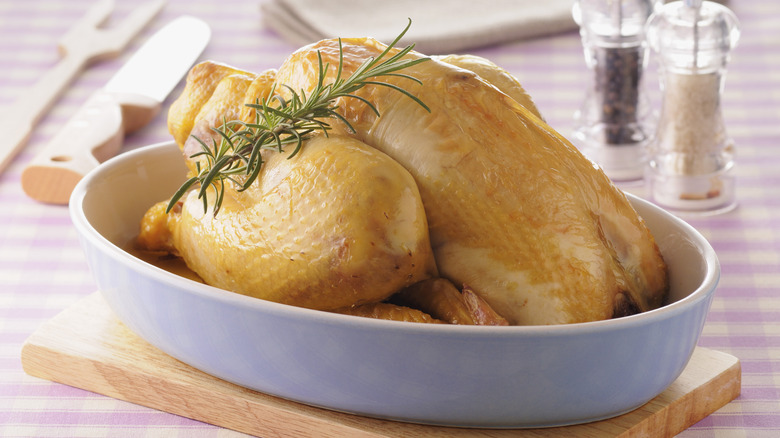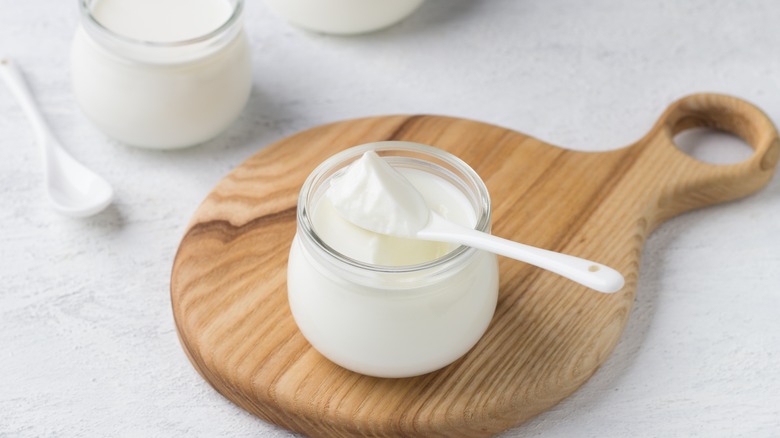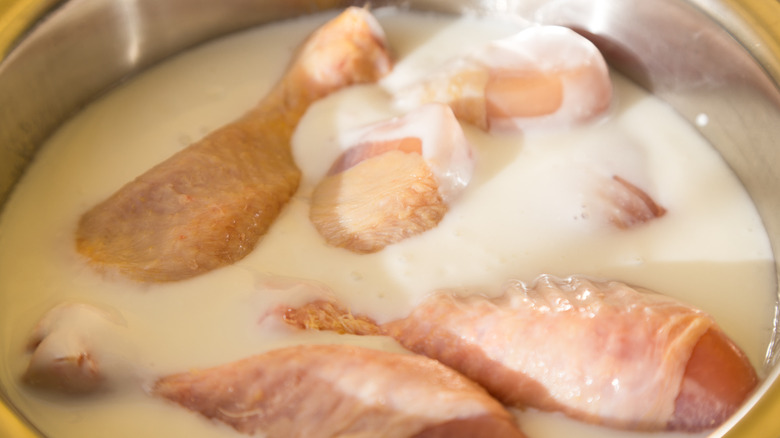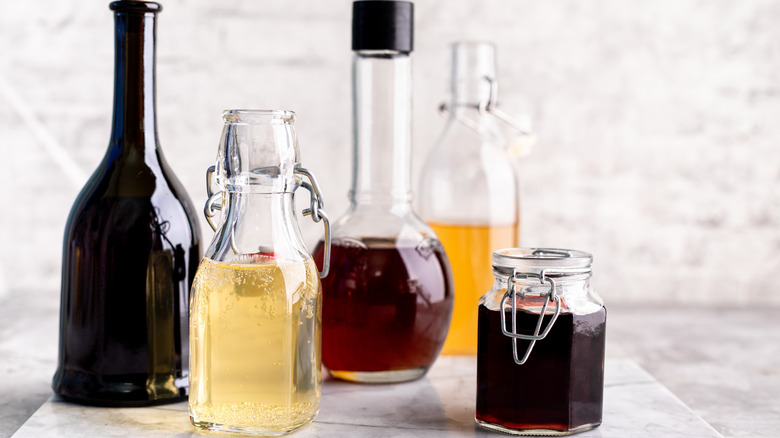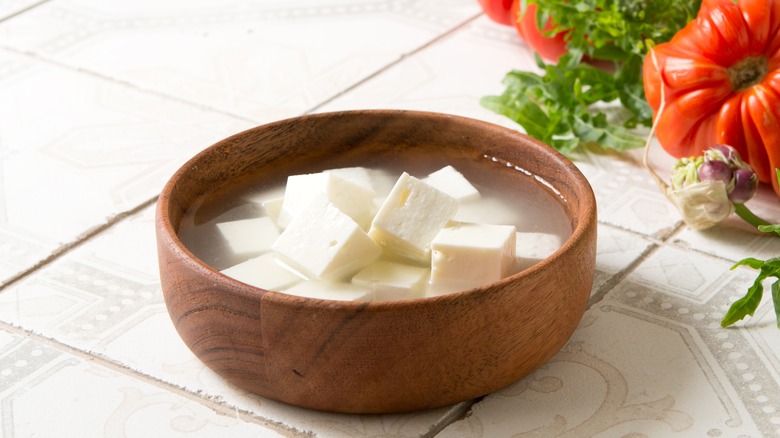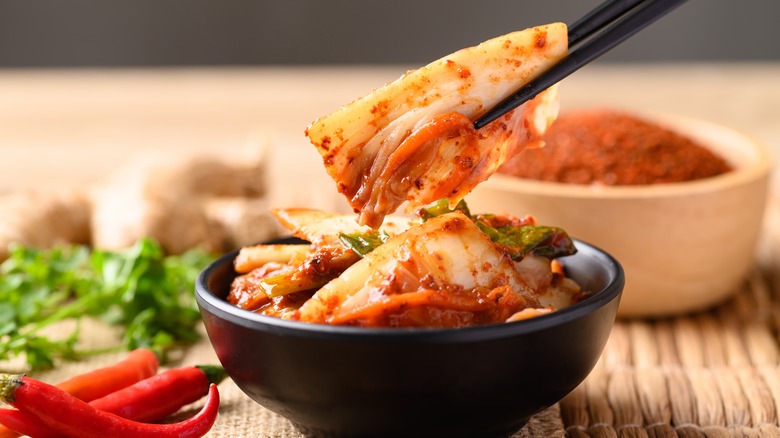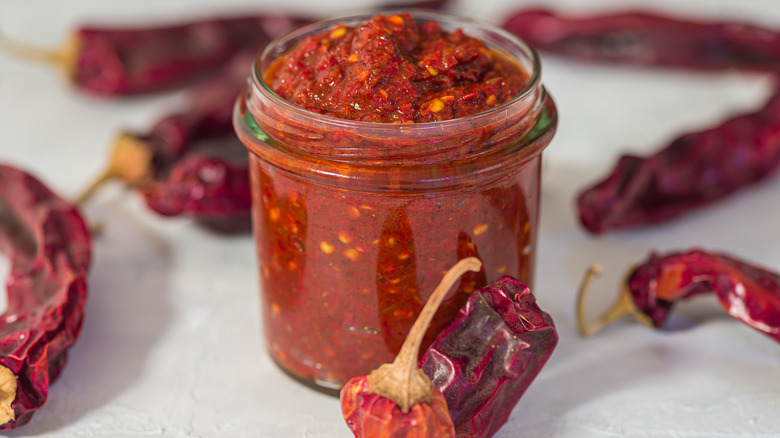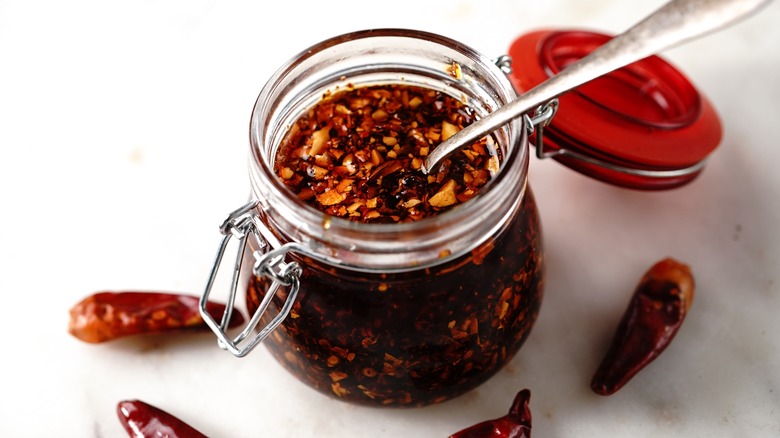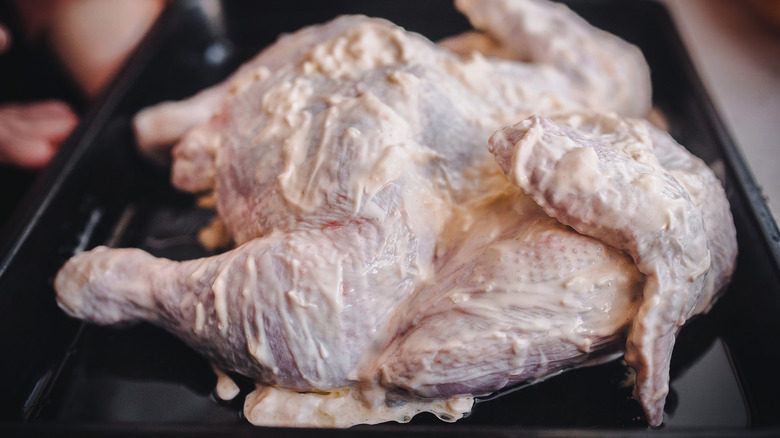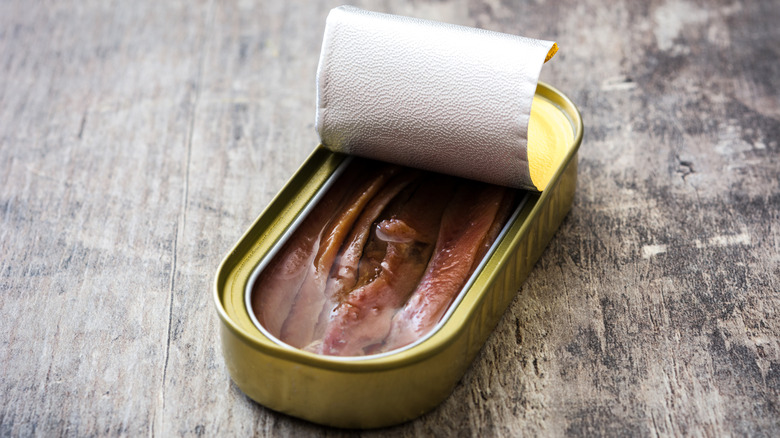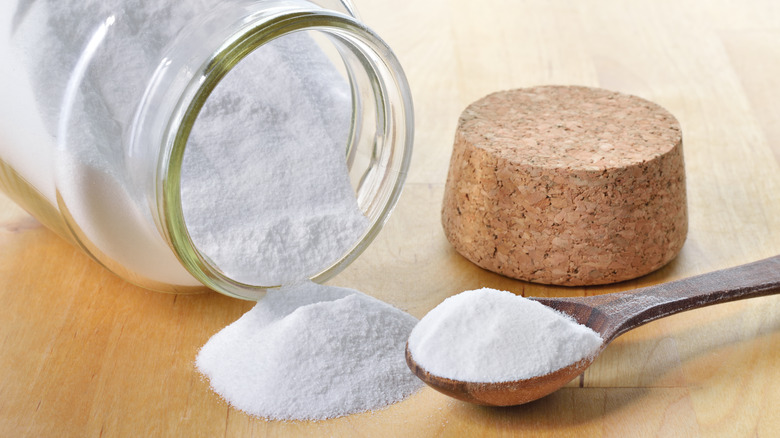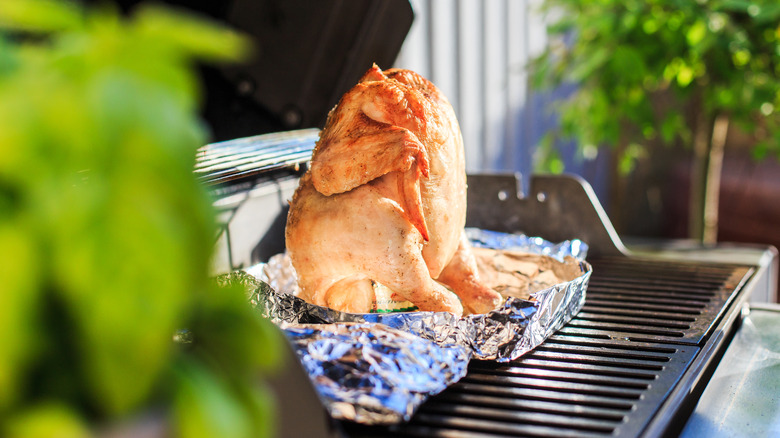11 Secret Ingredients You Should Be Using For Your Roasted Chicken
Roasted chicken is the rare dish that is at once humble enough for a lazy night in and, like any large-format protein, show-stopping enough to impress a crowd. Consequently, it has become a sort of litmus test for cooking competence. If you don't trust us, at least listen to Julia Child.
"I had come to believe that one can judge the quality of a cook by his or her roast chicken," the chef and author wrote in her memoir, "My Life in France." "Above all, it should taste like chicken: It should be so good that even a perfectly simple, buttery roast should be a delight."
Indeed, butter, along with other ingredients like wine, herbs, and lemon are more than adequate in producing a delicious bird. That being said, roasted chicken is nothing if not a blank canvas, with different marinades, acids, and fats all capable of improving upon the run-of-the-mill dish. In that spirit, why not expand your palate? Here are 11 ingredients that can up your roasted chicken game.
Yogurt makes a great marinade
Much of the crucial work of chicken cookery comes before the bird ever kisses the heat of the oven. When it comes to flavor-enhancing marinades, yogurt is a workhorse and has been for centuries. Indeed, preparing meat with yogurt is thought to have been a common cooking practice since the 13th century within the Central Asian expanses of the Mongolian Empire, where mare's milk was fermented into yogurt and used to marinate tough cuts of meat.
What exactly does a marinade do? Marinades improve the flavor of meat by steeping it in flavors, as well as tenderizing it. Acids are especially crucial in tenderizing meat — think of any marinade that contains citrus juice or vinegar — and yogurt might be the most successful in that capacity. Citrus and vinegar contain citric acid and acetic acid, respectively, which when left to marinate meat for too long can create a mushy, unpalatable texture. Lactic acid, which is found in yogurt, has a much milder effect, allowing for beautifully tender meat that can withstand an overnight marinade.
Yogurt marinades are ideal for high-heat cooking like broilers and grills, with the yogurt creating a protective coating whose sugars caramelize into a beautiful crust. It's a technique that works just as well for roasting. In addition to serving as a vehicle for herbs, spices, and garlic, marinating chicken with yogurt gives it a bright, tangy flavor. Full-fat, as with most products in the dairy aisle, is best.
So does buttermilk
If yogurt is fatty and tangy, then buttermilk is its leaner, thinner sibling, whose lactic acid content similarly works wonders on chicken. That being said, not all buttermilk is known for its high acid content. Traditionally, buttermilk is the milky byproduct left behind when churning cream into butter, but the tart and funky stuff we buy today is cultured buttermilk.
According to food historian Michael Twitty, buttermilk had low social currency in the United States. "It was favored by a lot of lower-class people, but the lower-class people were Scots-Irish and enslaved Africans," he told Eater. It was that latter group, he continued, that helped popularize buttermilk and make it a staple of southern cooking found in biscuits, pastries, and of course, chicken. "This is one of those foods and ingredients where the bridge between Africa, Europe, and America is very clear," Twitty continued.
While buttermilk is better known as a brine for fried chicken, it can't be discounted for roasting. When Samin Nosrat shared her recipe for buttermilk marinated roast chicken in her book-turned-TV series "Salt Fat Acid Heat," it became one of her most revered and widely shared contributions. Inspired by southern cooking, Nosrat's recipe calls for a 24-hour marinade of buttermilk and salt to tenderize the meat, produce a juicy bird, and encourage caramelization in the skin.
Vinegar chicken is a classic for a reason
As previously mentioned, vinegar can be a tricky chicken marinade. Its high acid makeup runs the risk of denaturing the proteins in the muscle, resulting in mushy or jerky-like chicken. But don't count out vinegar just yet. Beyond its capabilities in a marinade, vinegar is a welcome accompaniment to the bottom of a roasting pan.
The brightness of vinegar cuts through the rich, schmaltzy fat of roasted chicken, and it lends a fruity tang that is more complex than the oft-used lemon. Moreover, the character of vinegar changes throughout the cooking process. It mellows as it cooks, adding a fruity sweetness, and a sprinkling of the uncooked stuff on the finished product provides a zippy hit of acid.
Vinegar has a place in the upper echelons of chicken recipes. Chicken adobo, the national dish of the Philippines, predates the arrival of the Spanish in the island nation, despite the Spanish name. Vinegar was key in preserving meat in the humid climate. Today, versions of the dish exist around the world, incorporating the likes of apple cider vinegar, rice wine vinegar, white wine vinegar, and more.
Don't throw out your feta brine
We have seen the benefits of slathering dairy on your bird, but what about cheese brine? The translucent saltwater solution that holds bricks of feta cheese is a dark horse candidate for the most underrated roast chicken accouterment. The New York Times' Melissa Clark discovered the powers of the chicken-boosting elixir in 2015 when she reported on Souvla, a Greek restaurant in San Francisco. Looking to cut back on food waste, owner Charles Bililies and chef Tony Cervone concocted a use for the industrial amounts of feta brine they were discarding every day: They turned it into a brine for rotisserie chickens. The birds began selling like hotcakes.
Feta brine serves the same purpose as salt when used to prepare chicken, as the saline liquid seasons and tenderizes the meat from within. The brine also imparts an earthy flavor from the cheese, as well as a pleasant fermented funk that recalls a cheese-infused pickle juice. If you aren't working with commercial-sized vats of feta brine, the liquid can be stretched out by blending brine with additional water, salt, and cheese. The brine can be complemented by other Mediterranean flavors like lemon, oregano, black pepper, parsley, rosemary, and garlic.
Kimchi loves company
There are plenty of ways to get creative with kimchi, a cornerstone of Korean cuisine. It is just as at home eaten on its own as a banchan as it is as a flavor-boosting ingredient in stews like kimchi jjigae and budae jjigae, or as a sour, vegetal crunch in stir-fries and fried rice.
Early recordings of Korean fermentation practices date back to the 3rd century, when salting vegetables became a crucial form of preservation during the winter. Kimchi as we understand it today came into its own during the Joseon dynasty, which lasted from 1392 to 1897. During that time, napa cabbage, white radishes, and gochugaru all became kimchi staples. Today, there are numerous different types of kimchi, though the funky, fiery cabbage-based version (baechu) is perhaps the most well-known.
As kimchi ferments in a mix of ingredients that typically includes garlic, ginger, salted shrimp, scallions, and Asian pear, it produces our old friend lactic acid — the same stuff found in yogurt and buttermilk. The lactic acid lowers kimchi's pH, giving it its characteristic sour taste. It also makes kimchi an apt accompaniment to roast chicken. The sour bite cuts through the richness, and the lactic acid helps tenderize the meat.
Harissa adds a spicy kick
Chicken and peppers are a match made in heaven — a fact understood by anyone who has seasoned the protein with chili flakes or paprika. For even deeper complexity, consider reaching for harissa.
Harissa has roots in Tunisia, and it has become common across Morocco, Libya, Algeria, and Egypt. There, the ubiquitous condiment is made from a variety of dried and rehydrated peppers along with spices like coriander, caraway, cumin, and mint. Some glugs of good olive oil, and in some cases, garlic, bring the whole thing together, though citrus or vinegar are known to make an appearance as well. The consistency can range from a thick paste to a thin, loose sauce.
In North Africa, homemade harissa flavors stews and curries, and is used more broadly as a condiment for everything from takeout to pizza to warm bread. A number of chefs and recipe developers have recognized harissa's ability to add warmth and a lovely red hue to roasted chicken. Indeed, harissa is essentially a ready-made seasoning blend for poultry. The real star is perhaps the harissa-infused schmaltz that pools in the roasting pan.
Chili crisp adds heat and texture
Of all the ready-made chili condiments, perhaps none is having a bigger moment than Chinese chili crisp. The aromatic topping is made of some combination of dried chilies, oil, shallots, garlic, peanuts, sesame seeds, salt, and MSG. Grocery store shelves are lined with different brands of chili crisp, including Fly By Jing, started in 2018 by the Chengdu-born Jing Gao, and Lao Gan Ma, which has earned cult-like adoration since it began bottling its lip-smacking chili crisp in 1997.
Chili crisp has been touted for its use on the usual suspects like dumplings and noodles, though more left-field uses — think vanilla ice cream, peanut brittle, and watermelon salad — have emerged as well. In her article for Allrecipes, Devon O'Brien recounted with horror when she stumbled upon her husband slathering a bottle of chili crisp onto a raw chicken. To her delight, the condiment infused the chicken with flavor, and the oil added a lovely burnished finish. Indeed, the deeply savory oil flecked with alliums and Szechuan peppercorns seems a logical sub for olive oil or butter when seasoning chicken.
Mayonnaise isn't just for chicken salad
Adding oil or butter to a roasted chicken is optional. Indeed, the Thomas Keller method forgoes additional fat altogether, instead relying on salt and thoroughly dry skin to achieve a crispy bird. But for some cooks, fat is non-negotiable. Before you slather your chicken in butter or oil, consider an unlikely fat contender: mayonnaise.
Mayonnaise's secret powers as a Maillard reaction booster should be no surprise for anyone who likes to make grilled cheese. Swiping the outside of the bread with mayonnaise gives the sandwiches a superior crust — even better than butter, some would say. The results are arguably even better when applied to meat. Mayonnaise is primarily made of eggs and oil, in addition to some seasoning and acid for lift. In other words, it is mostly fat. Like yogurt, mayo is fat soluble, making it an excellent vehicle for other flavors that can make their way into the chicken. And since it is an emulsion, mayonnaise has a robust viscosity to keep it from dripping off of the chicken. Seasonings will stay suspended in the mayonnaise as well.
Mayonnaise helps trigger a Maillard reaction — the chemical reaction that results in food browning — in part because of the eggs, which don't evaporate during the cooking process. The protein and fat in the eggs stay in a thin layer on the protein and help with browning.
Embrace surf and turf
A roasted chicken is a deeply savory thing, thanks to naturally occurring levels of inosinate in the meat. When it comes to making sure your chicken packs an extra umami punch, there is perhaps no easier shortcut than preserved fish products. For those furrowing their brows, no, the chicken won't taste "fishy." Adding anchovies, fish sauce, or Worcestershire sauce to the party ensures an instant flavor bomb.
Umami — the punchy, at times elusive fifth taste — was discovered by Japanese biochemist Kikunae Ikeda in 1908 when he extracted glutamic acid from kelp. Ikea noticed that kelp-based dashi had a similarly savory quality as tomatoes, meats, and cheese, and he concluded that they all contained glutamic acid. Other umami-heavy ingredients include dried mushrooms, miso, and soy, though some of the most distinct flavors are fish-based.
The salting and curing of fish, as well as the production of fermented fish sauce, dates back to Roman times. Worcestershire sauce is fish sauce by another name, bolstered by ingredients like sugar, molasses, vinegar, tamarind, and onions. The salty fish products are at home in dishes like Caesar salads, pasta sauce, and plenty of Southeast Asian cuisine, but they are just as equipped to take roasted chicken to the next level. The briny flavor accents the chicken's own savoriness while cutting through the rich schmaltz. Moreover, fish products go hand in hand with classic roast chicken ingredients. Fish sauce's funkiness is easily tempered with butter, and anchovies are zippy and bright alongside alliums and herbs.
For crispy skin, look to your baking cabinet
Plenty of ingredients impart chicken with flavor, but for textural changes alone, look no further than baking powder. For culinarians and mad scientists alike, baking powder is an indispensable tool in the pursuit of crispy chicken skin.
Baking powder is slightly alkaline, and sprinkling it on top of a chicken causes the pH in the skin to rise. The proteins can then break down fast, leading to crispier, more evenly browned skin. As the baking powder mixes with juices from the chicken, it creates carbon dioxide, resulting in crispy air pockets on the skin.
For the baking powder to properly work its magic, combine one part baking powder with three to four parts kosher salt before sprinkling on the raw chicken skin. The only other ingredient is time. In order for the baking powder to do its thing, the chicken should be left uncovered in the refrigerator for 12 to 24 hours. This also gives the salt plenty of time to penetrate the meat, resulting in a deeper flavor and more moisture evaporation.
While the crispy skin works just as well with baking soda, which is also alkaline, it can impart a bitter, metallic flavor — so save the soda as a way to naturally clean your kitchen.
Split a beer with your bird
Wine is the de facto alcoholic beverage to glug into a roasting pan, but chickens are just as amenable to beer, perhaps most famously in the form of a beer can chicken. Novel, visceral, and infused with just a little bit of body horror, the beer can chicken method has cooks prop a whole chicken on top of a partially filled can of beer either in an oven or a grill (a 12-ounce can works fine, and a 16-ounce can will give the bird a bit more height).
The logic behind the madness is that the beer moistens the chicken from the inside, resulting in a uniquely tender bird. At the same time, propping the chicken upright allows the heat to penetrate it from all sides like a rotisserie. Any standard lager will do the job, with most beer can chicken connoisseurs avoiding anything too bitter or hop-forward.
Beer cans are lined with a Bisphenol A (BPA) plastic lining, but the amount of BPA is negligible under the FDA's guidelines. Still, if you would rather your chicken stay a teetotaler, propping it up on a vertical roaster will work fine, too.

